Asus 1000HE User Manual
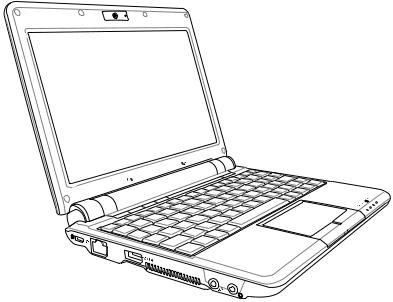
E4478
Eee PC User’s Manual
Windows® XP Edition
Eee PC 1000 Series
Eee PC 904 Series
Eee PC 901 Series
January 2009
15G06Q034201

Table of Contents
Chapter 1: |
Introducing the Eee PC |
|
About This User’s Manual............................................................................. |
1-2 |
|
Notes for This Manual.................................................................................... |
1-3 |
|
Safety Precautions.......................................................................................... |
1-4 |
|
Transportation Precautions....................................................................... |
1-6 |
|
Charging Your Batteries.............................................................................. |
1-6 |
|
Airplane Precautions.................................................................................... |
1-6 |
|
Preparing your Eee PC................................................................................... |
1-7 |
|
Chapter 2: |
Knowing the Parts |
Top Side.............................................................................................................. |
2-2 |
Bottom Side...................................................................................................... |
2-6 |
Right Side........................................................................................................... |
2-8 |
Left Side............................................................................................................ |
2-10 |
Rear Side.......................................................................................................... |
2-11 |
Chapter 3: |
Getting Started |
|
Power System................................................................................................... |
|
3-2 |
Using AC Power.............................................................................................. |
3-2 |
|
Using Battery Power..................................................................................... |
3-3 |
|
Battery Care..................................................................................................... |
3-4 |
|
Power Mode.................................................................................................... |
3-4 |
|
Emergency Shutdown & Reset................................................................. |
3-5 |
|
Touchpad Usage............................................................................................. |
3-6 |
|
Single-finger gesture input....................................................................... |
3-6 |
|
Multi-finger gesture input......................................................................... |
3-8 |
|
Keyboard Usage. |
............................................................................................. |
3-9 |
Special Function Keys.................................................................................. |
3-9 |
|
First-time Startup.......................................................................................... |
3-14 |
|
Desktop............................................................................................................ |
|
3-17 |
ASUS EeePC Tray Utility.............................................................................. |
3-18 |
|
Enabling and Disabling Devices............................................................ |
3-18 |
|
Adjusting the display resolution............................................................ |
3-19 |
|
Shutdown........................................................................................................ |
|
3-20 |
ii |
Table of Contents |

Table of Contents
Chapter 4: |
Using the Eee PC |
|
Network Connection..................................................................................... |
4-2 |
|
Configuring a wireless network connection....................................... |
4-2 |
|
Configuring a network connection........................................................ |
4-4 |
|
Browsing web pages.................................................................................. |
4-10 |
|
ASUS Update. |
................................................................................................. |
4-11 |
Updating the BIOS through the Internet............................................ |
4-11 |
|
Updating ................................................the BIOS through a BIOS file |
4-13 |
|
Bluetooth Connection(on .......................................selected models) |
4-14 |
|
ASUS Instant ...........................................................................................Key |
4-16 |
|
Super Hybrid ....................................................................................Engine |
4-17 |
|
Super Hybrid ...................................................................Engine Modes |
4-17 |
|
Eee Storage..................................................................................................... |
|
4-18 |
Video Conferencing..................................................................................... |
4-20 |
|
Chapter 5: |
Support DVD &System Recovery |
|
Support DVD information........................................................................... |
5-2 |
|
Running the support DVD......................................................................... |
5-2 |
|
Drivers menu.................................................................................................. |
5-2 |
|
Utilities menu................................................................................................. |
5-3 |
|
Contact |
........................................................................................................... |
5-4 |
Other information......................................................................................... |
5-4 |
|
System Recovery............................................................................................. |
5-5 |
|
Using the ..............................................................................Support DVD |
5-5 |
|
Using Hard ...........................................................................Disk Partition |
5-7 |
|
Boot Booster..................................................................................................... |
|
5-8 |
Appendix |
|
|
Declarations and ........................................................Safety Statements |
A-2 |
|
Federal ...........................Communications Commission Statement |
A-2 |
|
FCC Radio ................Frequency (RF) Exposure Caution Statement |
A-3 |
|
Declaration .................of Conformity(R&TTE directive 1999/5/EC) |
A-4 |
|
CE Mark ...........................................................................................Warning |
A-4 |
|
IC Radiation .....................................Exposure Statement for Canada |
A-4 |
|
Wireless .........................Operation Channel for Different Domains |
A-6 |
|
ASUS Eee PC |
iii |

France Restricted Wireless Frequency Bands...................................... |
A-6 |
UL Safety Notices.......................................................................................... |
A-8 |
Power Safety Requirement........................................................................ |
A-9 |
Nordic Lithium Cautions (for lithium-ion batteries)...................... |
A-10 |
Copyright Information............................................................................... |
A-12 |
Limitation of Liability.................................................................................. |
A-13 |
Service and Support................................................................................... |
A-13 |
iv |
Table of Contents |
About This User’s Manual
Notes for This Manual
Safety Precautions
Preparing Your Eee PC
Introducing1
the Eee PC

About This User’s Manual
You are reading the Eee PC User’s Manual.This User’s Manual provides information regarding the various components in the Eee PC and how to use them.The following are major sections of this User’s Manual:
1.Introducing the Eee PC
Introduces the Eee PC and this User’s Manual.
2.Knowing the Parts
Provides information on the Eee PC’s components.
3.Getting Started
Provides information on getting started with the Eee PC.
4.Using the Eee PC
Provides information on using the Eee PC’s utilities.
5.System Recovery
Gives you information on system recovery.
6.Appendix
Gives you safety statements.
The actual bundled applications differ by models and territories. There may be differences between your Eee PC and the pictures shown in this manual. Please accept your Eee PC as being correct.
1-2 |
Chapter 1: Introducing the Eee PC |
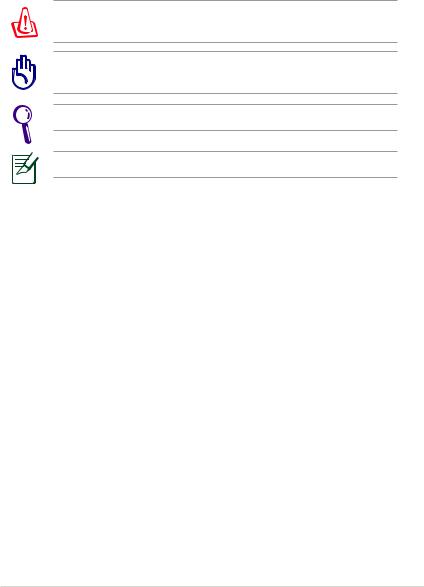
Notes for This Manual
A few notes and warnings are used throughout this guide, allowing you to complete certain tasks safely and effectively.These notes have different degrees of importance as follows:
WARNING! Important information that must be followed for safe operation.
IMPORTANT! Vital information that must be followed to prevent damage to data, components, or persons.
TIP:Tips for completing tasks.
NOTE: Information for special situations.
ASUS Eee PC |
1-3 |
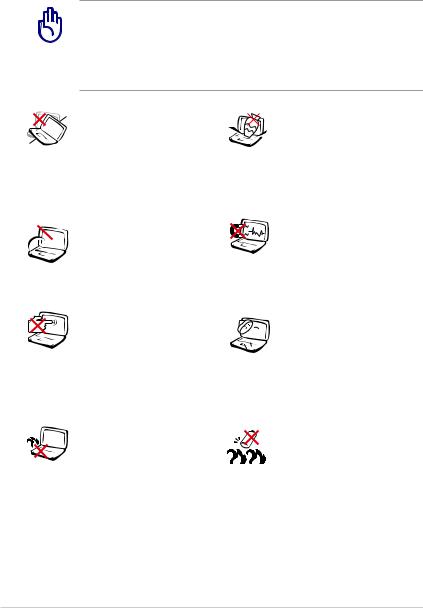
Safety Precautions
The following safety precautions will increase the life of the Eee PC. Follow all precautions and instructions. Except as described in this manual, refer all servicing to qualified personnel.
Disconnect the AC power and remove the battery pack(s) before cleaning.Wipe the Eee PC using a clean cellulose sponge or chamois cloth dampened with a solution of nonabrasive detergent and a few drops of warm water and remove any extra moisture with a dry cloth.
DO NOT place on uneven or unstable work surfaces. Seek servicing if the casing has been damaged.

 DO NOT expose to dirty or dusty environments. DO NOT operate during a gas leak.
DO NOT expose to dirty or dusty environments. DO NOT operate during a gas leak.
DO NOT press or touch  the display panel. DO NOT
the display panel. DO NOT 


 place together with small
place together with small
items that may scratch or enter the Eee PC.
DO NOT leave the Eee PC on your lap or any part of the body to prevent discomfort or injury from heat exposure.
DO NOT place or drop objects on top and do not shove any foreign objects into the Eee PC.
DO NOT expose to strong magnetic or electrical fields.
DO NOT expose to or use near liquids, rain, or moisture. DO NOT use the modem during electrical storms.
Battery safety warning: DO NOT throw the battery in fire. DO NOT short circuit the contacts. DO NOT disassemble the battery.
1-4 |
Chapter 1: Introducing the Eee PC |
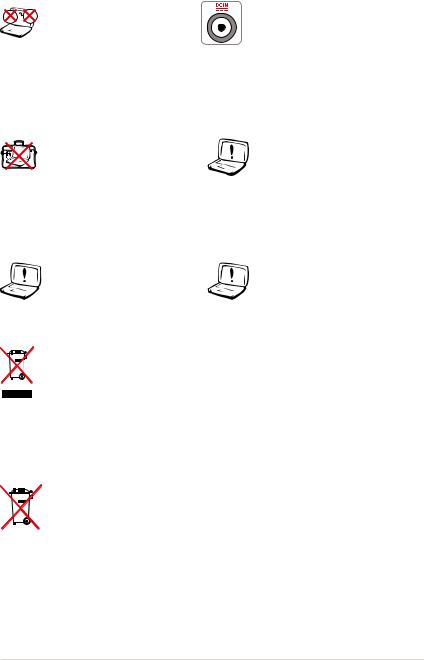





 SAFE TEMP:This Eee PC
SAFE TEMP:This Eee PC

 should only be used in environments with ambient temperatures
should only be used in environments with ambient temperatures
between 5°C (41°F) and 35°C (95°F)
DO NOT carry or cover an Eee PC that is powered ON with any materials that will reduce air circulation such as a carrying bag.
DO NOT use damaged power cords, accessories, or other peripherals.
INPUT RATING: Refer to the rating label on the bottom of the Eee PC and be sure that your power adapter complies with the rating.
DO NOT use strong solvents such as thinners, benzene, or other chemicals on or near the surface.
Incorrect installation of battery may cause explosion and damage the Eee PC.
DO NOT throw the Eee PC in municipal waste.This product has been designed to enable proper reuse of parts and recycling.The symbol of the crossed out wheeled bin indicates that the product (electrical, electronic equipment and mercury-containing button cell battery) should not be placed in municipal waste. Check local regulations for disposal of electronic products.
DO NOT throw the battery in municipal waste.The symbol of the crossed out wheeled bin indicates that the battery should not be placed in municipal waste.
ASUS Eee PC |
1-5 |

Transportation Precautions
To prepare the Eee PC for transport, you should close the display panel to protect the keyboard and display panel.
The Eee PC’s surface is easily dulled if not properly cared for. Be careful not to rub or scrape surfaces when transporting your Eee PC. You can put your Eee PC in a carrying case for protection from dirt, water, shock, and scratches.
For the model that comes with a hard disk drive, you should turn it OFF and disconnect all external peripherals to prevent damage to the connectors when you prepare for transport.The hard disk drive’s head retracts when the power is turned OFF
to prevent scratching of the hard disk surface during transport. Never transport it while the power is still ON.
Charging Your Batteries
If you intend to use battery power, be sure to fully charge your battery pack and any optional battery packs before going on long trips. Remember that the power adapter charges the battery pack as long as it is plugged into the computer and an AC power source. Be aware that it takes much longer to charge the battery pack when the Eee PC is in use.
Airplane Precautions
Contact your airline if you want to use the Eee PC on the airplane. Most airlines have restrictions for using electronic devices. Most airlines allow electronic use only between and not during takeoffs and landings.
There are three main types of airport security devices: X-ray machines (used on items placed on conveyor belts), magnetic detectors (used on people walking through security checks), and magnetic wands (hand-held devices used on people or individual items).You can send your Eee PC and diskettes through airport X-ray machines. However, it is recommended that you do not send your Eee PC or diskettes through airport magnetic detectors or expose them to magnetic wands.
1-6 |
Chapter 1: Introducing the Eee PC |
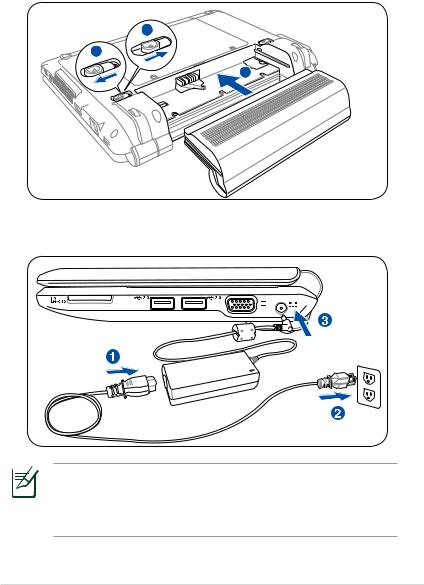
Preparing your Eee PC
These are only quick instructions for using your Eee PC. Read the following chapters for detailed information.
1.Install the battery pack
3
1
2
2.Connect the AC power adapter
Your Eee PC may come with either a two or three-prong plug depending on territory. If a three-prong plug is provided, you must use a grounded AC outlet or use a properly grounded adapter to ensure safe operation of the Eee PC.
ASUS Eee PC |
1-7 |
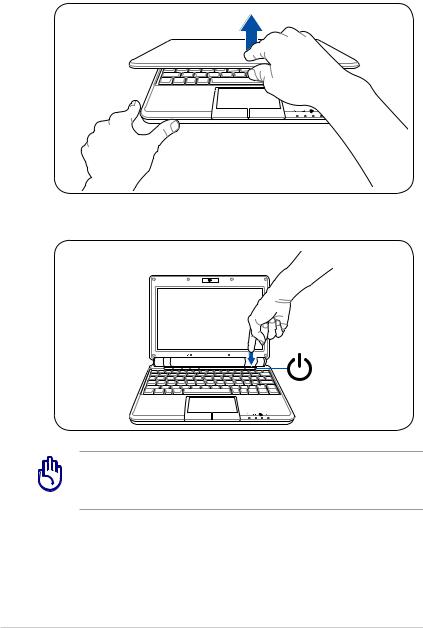
3.Open the display panel
4.Turn ON the Eee PC
1.3
When you open the display panel, do not force it down to the table or else the hinges may break! Never lift the Eee PC by the display panel!
1-8 |
Chapter 1: Introducing the Eee PC |
Top Side
Bottom Side
Right Side
Left Side
Rear Side
Knowing the Parts2
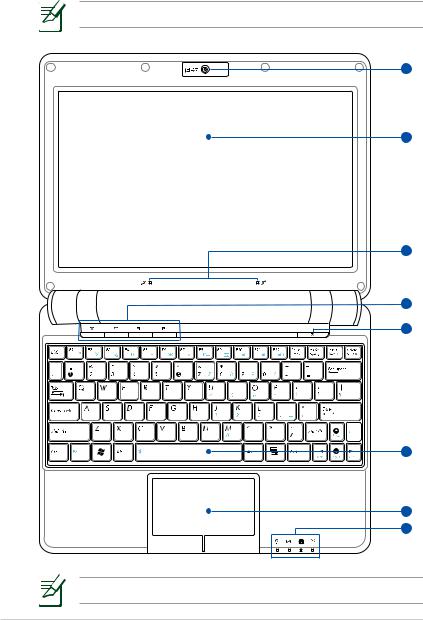
Top Side
Refer to the illustration below to identify the components on this side of the Eee PC.
The top side may vary in appearance depending on model.
1
2
3
4
5
6
7
8
The keyboard differs for each territory.
2-2 |
Chapter 2: Knowing the Parts |

1
2
3
4
Built-in Camera
The built-in camera allows picture taking or video recording.
Display Panel
The display panel functions the same as a desktop monitor. The Eee PC uses an active matrix TFT LCD, which provides excellent viewing like that of desktop monitors. Unlike desktop monitors, the LCD panel does not produce any radiation or flickering, so it is easier on the eyes. Use a soft cloth without chemical liquids (use plain water if necessary) to clean the display panel.
Array Microphone (Built-in)
The built-in array microphone is more clear and echo-free compared with traditional single microphones and can be used for video conferencing, voice narrations, audio recordings, and multimedia applications.
Instant Keys
Instant keys allow you to launch frequently used applications with one push of a button.
Backlight Key
Pressing this key turns off the LCD monitor backlight. Any action on the keyboard, mouse or touchpad will activate monitor again.
Resolution Key
The Resolution key allows you to adjust display resolution. Press this key repeatedly to switch resolution.
User-defined Key
This key is reserved for customized definition.The default definition is for Super Hybrid Engine function.
ASUS Eee PC |
2-3 |
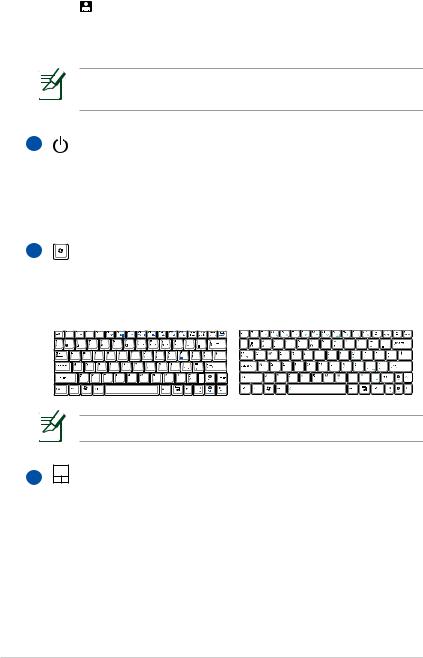
5
6
7
User-defined Key
This key is reserved for customized definition.The default definition is for launching Skype.
Only models with built-in wireless LAN and Bluetooth supoort the user-defined key for Skype.
Power Switch
The power switch allows powering ON and OFF the Eee PC and recovering from STR. Press the switch once to turn ON and hold it to turn OFF the Eee PC.The power switch only works when the display panel is opened.
Keyboard
The keyboard provides keys with comfortable travel (depth at which the keys can be depressed) and palm rest for both hands.
The keyboard differs depending on model.
Touchpad and Buttons
The touchpad and its buttons comprises a pointing device that provides the same functions as a desktop mouse. Multi-finger gesture input is available to allow easy web and document navigation.
2-4 |
Chapter 2: Knowing the Parts |
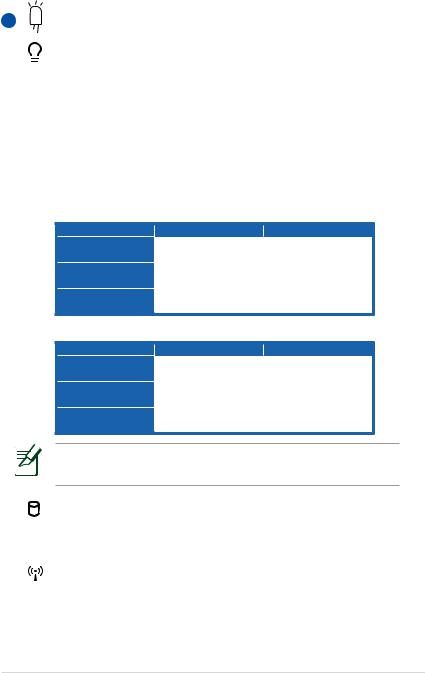
8 |
Status Indicators (front) |
Power Indicator
The power indicator lights when the Eee PC is turned ON and blinks slowly when the Eee PC is in the Save-to-RAM (Suspend) mode.This indicator is OFF when the Eee PC is turned OFF.
 Battery Charge Indicator
Battery Charge Indicator
The battery charge indicator (LED) shows the status of the
battery’s power as follows:
Powered ON
Battery charge is between 100%–80%
Battery charge is between 80%–10%
Battery charge is less than 10%
AC Mode |
Battery Mode |
Orange ON |
Green ON |
|
|
Orange Blinking Slowly |
Green Blinking Slowly |
Orange Blinking Quickly |
Green Blinking Quickly |
|
|
Standby Mode / Powered OFF
Battery charge is between 100%–80%
Battery charge is between 80%–10%
Battery charge is less than 10%
AC Mode |
Battery Mode |
Orange ON |
Off |
|
|
Orange Blinking Slowly |
Off |
|
|
Orange Blinking Quickly |
Off |
|
|
The Battery Charge Indicator will not light when the battery is removed from your Eee PC.
Solid-State disk (SSD)/Hard disk (HDD) Indicator
The solid-state disk drive/hard disk drive indicator blinks when data is written to or read from the disk drive.
Wireless/Bluetooth Indicator
This is only applicable on models with built-in wireless LAN/Bluetooth.When the built-in wireless LAN/Bluetooth is enabled, this indicator lights.
ASUS Eee PC |
2-5 |
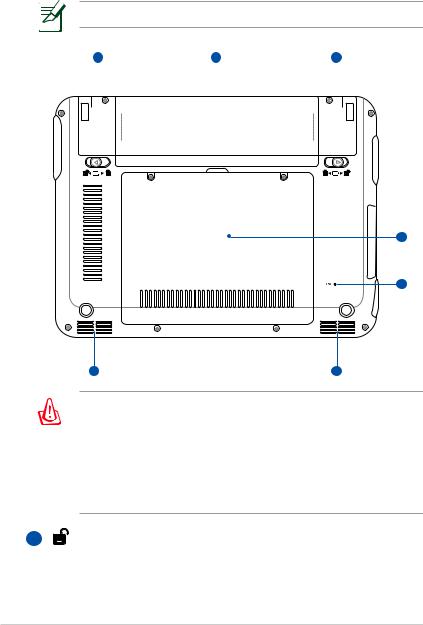
Bottom Side
Refer to the illustration below to identify the components on this side of the Eee PC.
The bottom side may vary in appearance depending on model.
1 |
2 |
3 |
|||
|
|
|
|
|
|
|
|
|
|
|
|
|
|
|
|
|
|
|
|
|
|
|
|
|
|
|
|
|
|
|
|
|
|
|
|
|
|
|
|
|
|
|
|
|
|
|
|
|
|
|
|
|
|
|
|
|
|
|
|
|
|
|
|
|
|
|
|
|
|
|
|
2 |
1 |
4
5
6 |
6 |
The bottom of the Eee PC can get very hot. Be careful when handling the Eee PC while it is in operation or recently been in operation. High temperatures are normal during charging or operation. DO NOT use on soft surfaces such as beds or sofas ,which may block the vents. DO NOT PUT THE Eee PC ON YOUR LAP OR OTHER PARTS OF THE BODY TO AVOID INJURY FROM THE HEAT.
1 |
Battery Lock - Spring |
The spring battery lock keeps the battery pack secure. When the battery pack is inserted, it will automatically lock. When removing the battery pack, this spring lock must be retained in the unlocked position.
2-6 |
Chapter 2: Knowing the Parts |
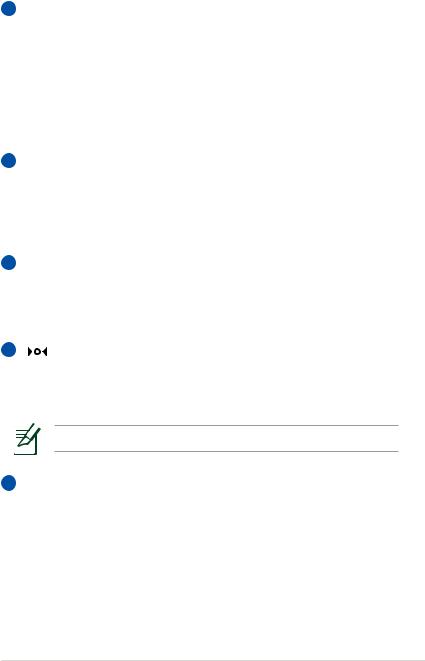
2  Battery Pack
Battery Pack
The battery pack is automatically charged when connected to an AC power source and maintains power to the Eee PC when AC power is not connected.This allows use when moving temporarily between locations. Battery time
varies by usage and by the specifications for this Eee PC. The battery pack cannot be disassembled and must be purchased as a single unit.
3  Battery Lock - Manual
Battery Lock - Manual
The manual battery lock is used to keep the battery pack secured. Move the manual lock to the unlocked position to insert or remove the battery pack. Move the manual lock to the locked position after inserting the battery pack.
4 Solid-State Disk/Hard disk drive
Solid-State Disk/Hard disk drive
&Memory Compartment
The solid-state disk drive/ hard disk drive and memory are secured in a dedicated compartment.
5 |
Reset Button (Emergency) |
In case your operating system cannot properly turn OFF or restart, the reset button can be depressed with a pin or a straightened paper clip to restart the Eee PC.
The reset button is available on selected models.
6 
 Audio Speaker System
Audio Speaker System
The built-in stereo speaker system allows you to hear audio without additional attachments.The multimedia sound system features an integrated digital audio controller
that produces rich, vibrant sound (results improved with external stereo headphones or speakers). Audio features are software controlled.
ASUS Eee PC |
2-7 |
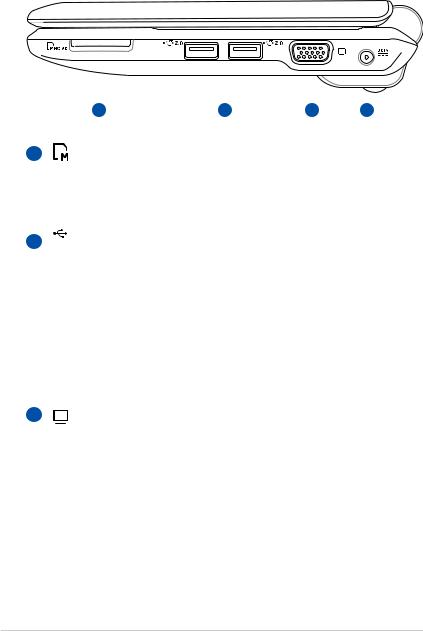
Right Side
Refer to the illustration below to identify the components on this side of the Eee PC.
|
|
|
|
|
|
|
|
|
|
|
|
|
|
|
|
|
|
|
|
|
|
|
|
|
|
|
|
1 |
2 |
3 |
4 |
||||
1 |
Memory Card Slot |
|
|
|
|
|
|
|
The built-in memory card reader can read MMC/SD cards from devices such as digital cameras, MP3 players, mobile phones, and PDAs.
2 2.0 USB Port (2.0/1.1)
The USB (Universal Serial Bus) port is compatible with USB 2.0 or USB 1.1 devices such as keyboards, pointing devices, cameras, and storage devices, connected in a series up to 12Mbits/sec (USB 1.1) and 480Mbits/sec (USB 2.0). USB allows many devices to run simultaneously on a single computer, with some peripherals acting as additional plug-in sites or hubs. Also, the USB supports hot-swapping function.
3 |
Display (Monitor) Output |
The 15-pin D-sub monitor port supports a standard VGAcompatible device such as a monitor or projector to allow viewing on a larger external display.
2-8 |
Chapter 2: Knowing the Parts |

4  Power (DC) Input
Power (DC) Input
The supplied power adapter converts AC power to DC power for use with this jack. Power supplied through this jack supplies power to the Eee PC and charges the internal battery pack.To prevent damage to the Eee PC and battery pack, always use the supplied power adapter.
CAUTION: MAY BECOME WARM TO HOT WHEN IN USE. BE SURE NOT TO COVER THE ADAPTER AND KEEP IT AWAY FROM YOUR BODY.
ASUS Eee PC |
2-9 |
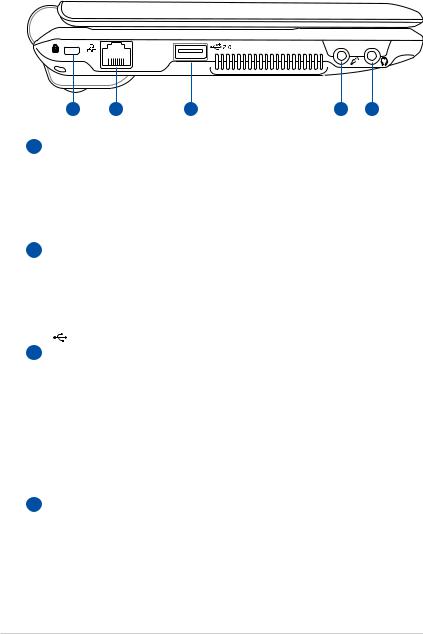
Left Side
Refer to the illustration below to identify the components on this side of the Eee PC.
1 |
2 |
3 |
4 |
5 |
1  Kensington® Lock Port
Kensington® Lock Port
The Kensington® lock port allows the Eee PC to be secured using Kensington® compatible security products.These security products usually include a metal cable and lock that prevent the Eee PC to be removed from a fixed object.
2  LAN Port
LAN Port
The eight-pin RJ-45 LAN port (10/100M bit) supports a standard Ethernet cable for connection to a local network. The built-in connector allows convenient use without additional adapters.
3 2.0 USB Port (2.0/1.1)
The USB (Universal Serial Bus) port is compatible with USB 2.0 or USB 1.1 devices such as keyboards, pointing devices, cameras, and storage devices, connected in a series up to 12Mbits/sec (USB 1.1) and 480Mbits/sec (USB 2.0). USB allows many devices to run simultaneously on a single computer, with some peripherals acting as additional plugin sites or hubs. Also, it supports hot-swapping function.
4  Microphone Jack
Microphone Jack
The microphone jack is designed to connect the microphone used for Skype, voice narrations, or simple audio recordings.
2-10 |
Chapter 2: Knowing the Parts |
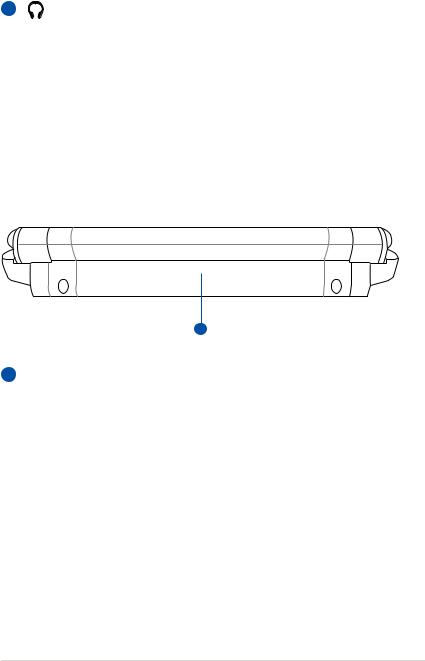
5 |
Headphone Output Jack |
The 1/8” stereo headphone jack (3.55mm) connects the Eee PC’s audio out signal to amplified speakers or headphones. Using this jack automatically disables the built-in speakers.
Rear Side
Refer to the illustration below to identify the components on this side of the Eee PC.
1
1  Battery Pack
Battery Pack
The battery pack is automatically charged when connected to an AC power source and maintains power to the Eee PC when AC power is not connected.This allows use when moving temporarily between locations. Battery time
varies by usage and by the specifications for this Eee PC. The battery pack cannot be disassembled and must be purchased as a single unit.
ASUS Eee PC |
2-11 |

2-12 |
Chapter 2: Knowing the Parts |
Power System
Touchpad Usage
Keyboard Usage
First Run Wizard
Operating Mode
Shutdown
Getting Started3
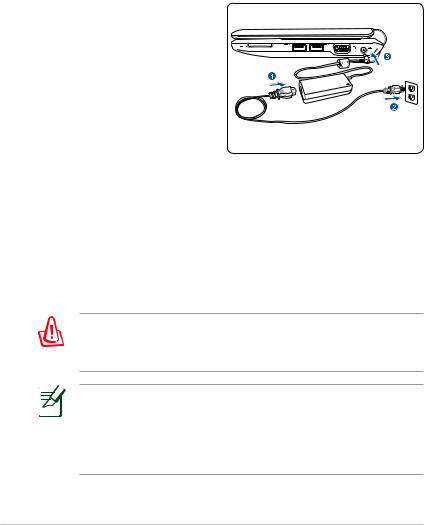
Power System
Using AC Power
The Eee PC power comprises two parts, the power adapter and the battery power system.The power adapter converts AC power
from a wall outlet to the DC power required by the Eee PC.Your Eee PC comes with a universal AC-DC adapter for connection to any 100V-120V as well as 220V-240V outlets without setting switches or using power converters. Different countries may require an adapter to connect the provided US-
standard AC power cord to a
different standard. Most hotels will provide universal outlets to support different power cords as
well as voltages. It is always best to ask an experienced traveler about AC outlet voltages before
travelling.
With the AC power cord connected to the AC-DC converter, connect the AC power cord to an AC outlet (preferably with surge-protection) and then connect the DC plug to the Eee PC. Connecting the AC-DC adapter to the AC outlet first allows you to test the AC outlet’s power and the AC-DC converter itself for compatibility problems before connecting the DC power to the Eee PC.The power indicator on the adapter (if available) will light if the power is within accepted ranges.
THE POWER ADAPTER MAY BECOME WARM TO HOT WHEN IN USE. BE SURE NOT TO COVER THE ADAPTER AND KEEP IT AWAY FROM YOUR BODY.
This Eee PC may come with either a two or three-prong plug depending on territory to fit your wall outlet. If a three-prong plug is provided, you must use a grounded AC outlet or use a properly grounded adapter to ensure safe operation of the Eee PC.
3-2 |
Chapter 3: Getting Started |
